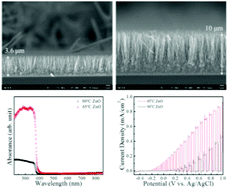Enhancing the quasi-theoretical photocurrent density of ZnO nanorods via a lukewarm hydrothermal method
Abstract
A ∼10-μm-long one-dimensional (1D) ZnO nanorod array (NRA) vertically oriented on a fluorine-doped tin oxide (FTO) coated glass substrate is successfully fabricated via a lukewarm hydrothermal method. The reflection of light from the rough surface of this ultralong ZnO NRA, resulting from the variation in the characteristic length of individual ZnO NRs in a tapered geometry, is largely suppressed. This in turn favors the ZnO NRA as a photoelectrode effectively harnessing UV-light for solar water splitting, as evidently manifested in the quasi-theoretical photocurrent density that reached ∼0.9 mA cm−2 at 1VAg/AgCl. A further contribution to such an outstanding performance stems from additional photocurrent generation by the ZnO NRA upon visible light illumination. This is attributed to a variety of native defects and the surface hydroxyl groups present in the ZnO NRA, giving rise to the mid-gap states that mediate the associated electronic transitions. Moreover, those lattice imperfections further boost the carrier concentration of the ZnO NRA to facilitate the carrier transport which in turn enhances the photoelectrochemical activity.



 Please wait while we load your content...
Please wait while we load your content...